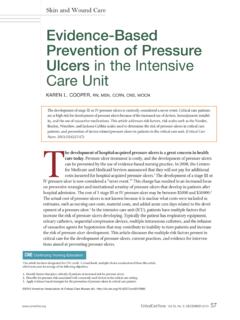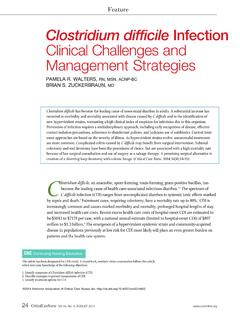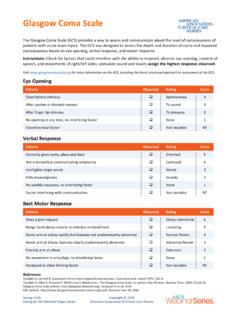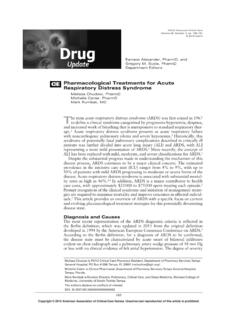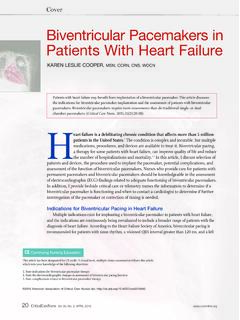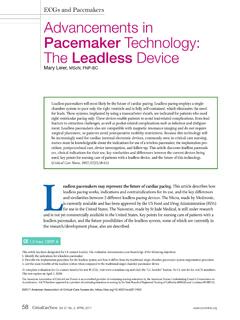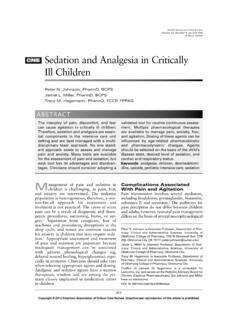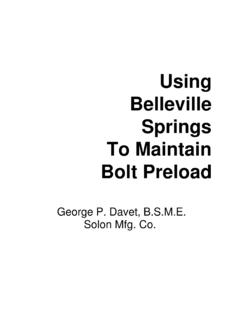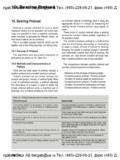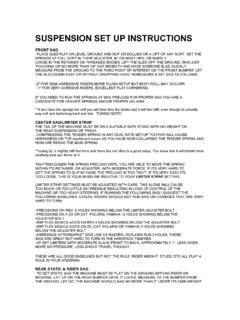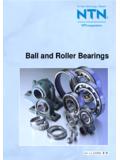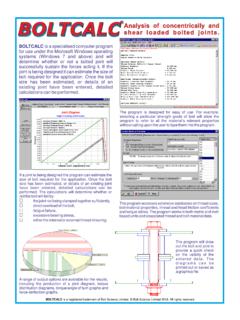Transcription of CCRN CV1 - BL - SK hflb - SK JM for Handout
1 CardiovascularCardiovascularAdult CCRN/CCRN E/CCRN K Certification Review Course:Cardiovascular, Part 1 Barbara Bobbi LeeperRN BC, MN, CNS MS, CCRN, FAHAC ardiovascular The speaker has received honoraria from Edwards LifesciencesDisclosures12/2015 Cardiovascular, Part 11 CardiovascularAfter the completion of this program, participants will be able the critical care needs that patients with single and multisystem organ abnormalities have in assessment strategies and treatment options for common critical care the pathophysiology of single and multisystem dysfunction,as well as the pharmacological management of the AACN Synergy Model for Patient Care and the blueprint for the CCRN certification examCourse ObjectivesCardiovascularCaring & Ethical Practice 20%Clinical Judgment 80%Blueprint/Test PlanCardiovascularCCRN Examination Blueprint/Test Plan Exam consists of 150 multiple choice questions 125 are scored 25 are used for item analysis for future questions12/2015 Cardiovascular, Part 12 Cardiovascular Cardiovascular18% Pulmonary17% Multisystem14% Neurology, Musculoskeletal13%Behavioral/Psychosocia l Endocrine, Hematology18%Gastrointestinal.
2 Renal/Genitourinaryand IntegumentaryClinical Judgment = 80%Cardiovascular Advocacy/Moral Agency Caring Practices Collaboration Systems Thinking Response to Diversity Clinical Inquiry Facilitator of LearningProfessional Caring & Ethical Practice = 20%CardiovascularTestable Nursing Actions Normal/abnormal physical assessment Apply leads for ECG monitoring Monitor hemodynamic status Manage patients receiving CV medications Recognize indications for and manage patients with intraaortic balloon pump (IABP) or following percutaneous coronary intervention Recognize indications for and manage patients requiring 12 lead ECG Arterial line Monitoring: pulmonary artery catheter (PAC)/central venous pressure (CVP)/mixed venous oxygen saturation Defibrillation Pacing: transthoracic/transvenous Recognize signs and symptoms of cardiovascular emergencies, indicate interventions, and seek assistance as needed12/2015 Cardiovascular, Part 13 Cardiovascular Review of hemodynamic parameters Manipulating hemodynamics, cardiovascular drugs Shock Heart failure Myocardial infarction Aortic aneurysmsRoad Map: Cardiovascular SystemCardiovascularDirect and Derived Hemodynamic Volume of blood ejected by the heart in 1 minute Formula: heart rate x stroke volume Normal: 4 8 L/minCardiac Output12/2015 Cardiovascular, Part 14 Cardiovascular Formula: CO BSA Normal.
3 L/m2/min SignificanceCardiac IndexCardiovascular Heart rate Bradyarrhythmias Sinus bradycardia, junctional rhythms, AV blocks Consider if atrial kick is intact Do not rely on blood pressure to determine stabilityHeart Rate x Stroke VolumeCardiovascularEffect of Heart Rate on Cardiac Cycle One cardiac cycle = 1 second (HR 60/min)Systole 30%Diastole 70%One cardiac cycle = second (HR 90/min)Systole 45%Diastole 55%One cardiac cycle = sec (HR 120/min)Systole 60%Diastole 40%12/2015 Cardiovascular, Part 15 Cardiovascular Volume of blood ejected with each heartbeat Normal: 60 100 mL/beat Stroke volume index (SVI): 35 60 mL/m2 Determinants preload Afterload ContractilityStroke VolumeCardiovascularPreloadUsed with permission from Edwards LifesciencesCardiovascular Volume of blood in the ventricle at the end of diastole In practice: pressure generated by the volume of blood in the ventricle at the end of diastole How to assess?
4 RV: CVP RA pressure/RVEDVI LV: PAOP/PAD/LA pressure/dynamic parameters: (SVV/PPV/SPV)PreloadRVEDVI, right ventricular end diastolic volume index; PAOP, pulmonary artery occlusion pressure12/2015 Cardiovascular, Part 16 Cardiovascular CVP Normal: 0 5 mmHg Optimal: Varies 10 mmHg PAOP Normal: 6 12 mmHg Optimal: 14 18 mmHg in the critically ill patient RVEDVI: Optimize using Frank Starling curve Dynamic parameters: SVV/PPV/SPV: 10% 15%PreloadCardiovascularFrank Starling PrincipleEnd diastolic volume (mL)Stroke volume (mL)PreloadCardiovascular Reducing preload Diuretics Vasodilators: Think venous bed Increasing preload Volume Vasoconstriction of venous bedPreload12/2015 Cardiovascular, Part 17 Cardiovascular Definition Clinical implicationsAfterloadUsed with permission from Edwards LifesciencesCardiovascular Pressure the ventricle must generate to open the semilunar valve and eject its contents Assessment of afterload Left ventricle: Systemic vascular resistance (SVR) Right ventricle.
5 Pulmonary vascular resistance (PVR)AfterloadCardiovascular The higher the afterload, the greater the work Increases myocardial oxygen demands May decrease contractility RV more sensitive than the LV Some afterload is necessary to contribute to contractilityAfterload 12/2015 Cardiovascular, Part 18 CardiovascularEffects of Changes in AfterloadStroke volumeAfterloadAfterloadMyocardialVO2 Used with permission from Edwards LifesciencesCardiovascular Reflects overall resistance or impedance to systolic ejection Greatest resistance to flow in small arteries and arterioles Formula: 80 x (MAP RAP)/CO Normal: 800 1200 dynes/sec/cm 5 SVRI: 1970 3900 dynes/sec/cm 5/m2 Systemic Vascular ResistanceMAP, mean arterial pressure; RAP, right arterial pressureCardiovascular Increased Volume infusions Peripheral vasoconstriction Low CO states Hypothermia blood viscosity Hypovolemia Vasopressors LV failure Alpha adrenergic agentsSystemic Vascular Resistance Decreased Diuretics Vasodilators Hyperdynamic phase of sepsis Peripheral vasodilation Loss of vasomotor tone12/2015 Cardiovascular, Part 19 Cardiovascular Use of vasodilators Nitroglycerin Nicardipine Hydralazine (Apresoline) Isosorbide dinitrate (Isordil) Calcium channel blockers Sodium nitroprusside ACE inhibitors/angiotensin II (AII) receptor blockersReduction of AfterloadCardiovascular Use of pressors (ie, vasoconstrictors) High dose epinephrine Phenylephrine (Neo Synephrine) Norepinephrine (Levophed)
6 High dose dopamine VasopressinIncreasing AfterloadCardiovascular Resistance or impedance to RV ejection Formula: 80 x (MPAP PAOP)/CO Normal: <250 dynes/sec/cm 5 PVRI: 255 285 dynes/sec 5/m2 Pulmonary Vascular ResistanceMPAP, mean pulmonary artery; PAOP, pulmonary artery occlusion pressure; PVRI, pulmonary vascular resistance index12/2015 Cardiovascular, Part 110 Cardiovascular Increased Hypoxia Pulmonary edema Acute respiratory distress syndrome Pulmonary emboli Congenital heart defects Positive end expiratory pressure Pulmonary hypertension Sepsis Valvular heart diseasePulmonary Vascular Resistance Management Vasodilator therapy Correction of hypoxia Prostaglandins ProstacyclinCardiovascularContractility Ability of the heart to modulate its contractile performance independent of preload and afterload Assessment Stroke work/stroke work Index Stroke volume indexCardiovascular Stroke work/index LVSWI: SVI (MAP PAOP) x Normal: 50 62 gm m/m2/beat RVSWI: SVI (MPAP RAP) x Normal.
7 5 10 gm m/m2/beatVentricular ContractilityLVSWI, left ventricular stroke work index; RVSWI, right ventricular stroke work index12/2015 Cardiovascular, Part 111 Cardiovascular Normal range: 15 25/6 12 mmHg Clinical significance High readings Pulmonary hypertension Primary Secondary Low readings HypovolemiaPulmonary Artery PressureUsed with permission from Edwards LifesciencesCardiovascular Normal range: 6 12 mmHg Clinical significance High readings LV failure Valvular heart disease Cardiac tamponade Low readings Hypovolemia?Pulmonary Artery Occlusion PressureUsed with permission from Edwards LifesciencesCardiovascular Average pressure in circuit during systole and diastole Formula: [SBP + (2 x DBP)] / 3 Normal: 70 105 mmHg Used to determine perfusion pressure of vital organs <60 mmHg perfusion deficits begin to occur <40 mmHg cardiovascular collapse Mean Arterial Pressure12/2015 Cardiovascular, Part 112 Cardiovascular Increased Volume infusions Peripheral vasoconstriction Increased contractility Hypervolemia VasopressorsMean Arterial Pressure Decreased Diuretics Peripheral vasodilation Inotropic therapy Hypovolemia VasodilatorsCardiovascular Average pressure in the pulmonary circuit during systole and diastole Formula: [SPAP + (2 x DPAP)] / 3 Normal.
8 10 20 mmHgMean Pulmonary Artery PressureSPAP, systolic pulmonary pressure; DPAP, diastolic pulmonary artery pressureCardiovascular Increased Volume infusion Pulmonary vasoconstriction LV contractility Hypervolemia Hypoxia COPD Pulmonary hypertensionMean Pulmonary Artery Pressure Decreased Diuretics Pulmonary vasodilation Inotropic therapy Hypovolemia12/2015 Cardiovascular, Part 113 CardiovascularReview QuestionsCardiovascularQuestion 1 Determinants of stroke volume are:A. Heart rate, cardiac output, systolic BPB. preload , afterload, contractilityC. Cardiac index, diastolic BP, heart rateD. Mean arterial pressure, cardiac output, heart rateCardiovascularQuestion 1 RationaleB. preload , afterload, contractility Heart rate, cardiac output, systolic BP Incorrect; HR and SBP can affect SV but do not determine SV.
9 Stroke volume is a determinant of cardiac output Cardiac index, diastolic BP, heart rate Incorrect; SVI determines CI. Diastolic BP and heart rate may affect SV Mean arterial pressure cardiac output, heart rate Incorrect; stroke volume is a determinant of cardiac output. Heart rate and MAP may affect stroke volume but are not a major determinantDeterminants of stroke volume are:12/2015 Cardiovascular, Part 114 CardiovascularQuestion 2 Afterload is defined as:A. Decreased resistanceB. VasodilationC. Increased resistanceD. Mean arterial pressureCardiovascularQuestion 2 RationaleC. Increased resistance due to vasoconstriction of the vascular bed Decreased resistance incorrect; this is an increase in resistance Vasodilation incorrect; vasoconstriction is necessary for an increase in afterload Mean arterial pressure incorrect; does not give as much information about afterloadAfterload is defined as:CardiovascularQuestion 3 Two important events occur during diastole.
10 They are:A. Ventricular filling and coronary perfusionB. Ventricular contraction and coronary perfusionC. Shortening of protein filaments and coronary perfusionD. Ventricular depolarization and coronary perfusion12/2015 Cardiovascular, Part 115 CardiovascularQuestion 3 RationaleA. Ventricular filling and coronary perfusion Ventricular contraction and coronary perfusion Incorrect; during systole, the ventricles are emptying and very little coronary blood flow occurs Shortening of protein filaments and coronary perfusion Incorrect; shortening of the protein filaments is myocardial contraction (systole: ventricle ejecting blood) Ventricular depolarization and coronary perfusion Incorrect; ventricular depolarization immediately precedes ventricular systole (or ejection) Two important events occur during diastole.
